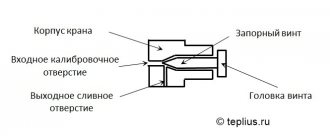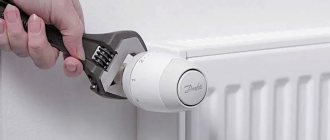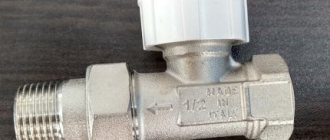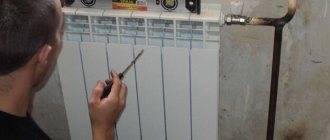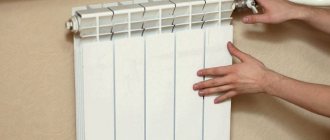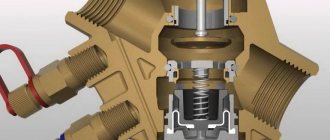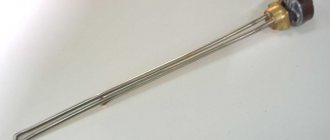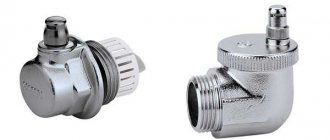Tell me, there is a Sira battery, there is a valve on the return line - a cap is screwed on top, and under it there is a hole for a hexagon. Question - what size hexagon? At 10 it dangles, at 12 it doesn’t fit. 11mm hex? Or what is the inch size? I can’t find it anywhere in stores, everywhere there’s a maximum of 10. Tell me where to look, preferably in the north of Moscow. And another question, how to open such a valve correctly? Nothing will leak there?
Despite the apparent complexity, repairing and modifying a heating radiator, with the proper skill and suitable tools, does not pose a problem for an experienced “home” craftsman, especially if the apartment has a fairly modern heating system. The most important tool in such work is radiator wrenches. This review examines the types of such keys, as well as the features of making their homemade versions.
Types of work with heating radiators
Currently, many apartments have modern bimetallic or aluminum heating radiators. Such units can be monolithic or sectional. The difference is that in sectional models it is possible to install and dismantle individual standard sections.
Such devices are specially designed to be as easy to disassemble as possible. Therefore, adding/removing individual sections can be done not only for the purpose of repairing and replacing damaged elements, but also to adjust the thermal balance of the room. Adding sections will increase the average temperature in the room, while removing them will decrease it.
Almost all models of old cast iron radiators, installed back in Soviet times, theoretically provide for the possibility of freely removing or adding individual modules. In practice, over many years of operation of such products, the fastening parts, under the influence of many heating/cooling cycles and as a result of reactions with the coolant, “stick” to the radiator and to each other, so it is advisable to remove sections of cast iron radiators only for the purpose of replacing them or completely dismantling them.
Heating radiators can be called the most famous equipment, since almost every person has encountered it. However, not everyone understands what is needed to install such a seemingly simple device and how its component elements work. In particular, we are talking about the radiator cap, which most likely not many people know about.
What are the advantages of an angle faucet?
All described properties are advantages. An additional advantage is that with such shut-off valves you can regulate the temperature of each radiator, regardless of the heating system. For example, if you need to reduce the temperature in a room that is rarely used, you simply need to reduce the supply of coolant in the radiator batteries installed in it. Or vice versa.
More often, angle-type valves are installed in cases where the pipe supply to the radiators is located at an angle of 90º.
Other advantages:
- Compactness. A small device with enormous functionality - this was the task set for the manufacturers. It should not stand out and fit even in inconvenient places.
- Typically, radiators are connected to pipes that are laid parallel to the walls. Today, many pipelines are recessed into the same walls to make the pipework invisible. The radiator can be connected using bends, and then a direct coolant regulator can be mounted. It is easier to install an angle tap, which combines two elements in the design.
- High reliability. The corner taps offered on the market are high quality products. And this despite the simplicity of the design.
- Easy to install. Since corner locking devices are installed in limited space, it was the issue of installation that faced the developers as a component of quality. Hence the speed and reliability of fixation.
- They are convenient to use. To do this, you need to turn the locking mechanism to one side.
- Appearance. More often than not, this type of shut-off valve is visible, so manufacturers try to pay a lot of attention to its design.
We have to give credit to the companies that are always working on corner cranes. This is not only about design, but also about increasing their functionality. For example, models with a thermometer installed on one of the pipes. A convenient option is that it can be used to monitor the temperature of the coolant.
Basic elements for radiator installation
In most cases, radiators are sold assembled; to operate, the device only needs to be fixed on the wall and connected to the heating system. However, in addition to this, you will need to purchase additional devices. These include the following:
- Pass-through plug for a cast iron radiator in an amount of at least 2 pieces. The device has holes on both sides in which threads are cut.
- Plugs that are screwed into the radiator body to prevent coolant leakage.
- Mayevsky taps for bleeding air from a heating device.
- Devices for installing radiators, these can be metal anchors or special brackets.
The number of radiator sections is determined by the need for thermal energy, so the length of the heating device is increased or shortened.
Modern specialized stores offer radiators and a full set of accessories for their installation. This allows you to select elements of the same color in accordance with the color of the heating device. In addition, in this case it is possible to select the most compatible materials. For example, if the battery is made of cast iron, then the plugs should also be cast iron. It is not recommended to use a plug for a cast iron radiator on copper heating appliances.
Due to the high risk of galvanic corrosion effects, it is very important to consider the combination of materials. In addition, individual metals tend to form a galvanic couple, in this case the cast-iron radiator plug becomes a cathode, and the material from which the pipe is made turns into an anode. As a result, the service life of the heating device is significantly reduced.
What you should pay attention to when choosing an angle tap
Attention must be paid to the heating system in which it will be installed. There are three of them:
- centralized;
- autonomous;
- heating in the form of boilers installed in multi-storey buildings directly next to or inside the building.
Each system has its own characteristics in terms of temperature and coolant pressure. Hence the norms of choice in accordance with these parameters. For example, in houses with more than five storeys, the coolant pressure is 5-12 atm. Less than five – 2-3 atm. In an autonomous system - no more than 2 atm.
The coolant temperature depends on the average temperature of the region:
- at -20 ℃ – the coolant temperature should be 65-80 ℃;
- at -40 ℃ – 95-105 ℃.
You cannot install an angle valve on a radiator in a multi-story building if it is designed for a pressure of 2 atm. It's the same with temperature.
The second point is the diameter of the shut-off valves. This size must be indicated on the product itself. When selected, it must be identical to the diameter of the pipe to which it is attached.
The third position is the material from which the locking device is made. There are three options here:
- stainless steel;
- brass;
- polypropylene.
The first is expensive, but reliable, with a long service life - up to 50 years. The second is cheap and less reliable. Will last no more than 7-8 years. But this period is not bad either. The most popular is the third option:
- service life – 15 years;
- withstands pressure up to 10 atm, temperature up to +90 ℃.
Today on the market you can come across corner taps made of silumin. It is an alloy of aluminum and silicon. It is difficult to distinguish it from stainless steel by appearance. Product characteristics are low. For example, the service life does not exceed 12 months. The price of silumin faucets is low.
The fourth selection criterion is the installation method.
There are four positions here:
- with internal thread on two tap pipes:
- with external thread;
- combined version - one pipe has an external thread, the other has an internal thread;
- Angle valve with American connection for radiator.
The latest model is preferred. The thing is that it allows you to install the tap without changing the location of the pipe and the shut-off valves themselves. To do this, you need to unscrew or tighten the union nut, which is attached to the radiator using a threaded pipe fitting. This is especially important when it is necessary to dismantle the radiator battery. There is no need to cut something and then weld it.
The fifth selection criterion is the ability to pass a certain amount of coolant through it.
| Type of corner device | Throughput, % |
| Full bore | 100 |
| Partial bore | up to 50 |
| Standard | 70-80 |
For heating radiators, it is better to choose a full-bore option. It will ensure the free passage of coolant without any problems. This type of shut-off valve can only reduce the passage of the pipe through which hot water moves to the radiator. He cannot increase it.
Rules for the selection and installation of plugs
The simplest element used when installing and assembling radiators is an aluminum plug for heating radiators. But even the simplest device requires special attention, otherwise big problems may arise during operation.
The process of installing a radiator plug cannot be called complicated, since almost all of them are made of the same type; the dimensions or type of thread may be different. Such devices also work on the same principle.
When choosing a radiator cap, it is important to consider the following points:
- The materials of the radiator and plug must be combined.
- The thread of the plug must be of a certain type. For example, for installation on the left side of the battery, it is recommended to use a left-hand thread, and on the right side, install a radiator plug with a right-hand thread.
- The hole in the radiator can be closed with a blind or through plug.
- The device must have an aesthetic appearance and match the color of the heating device.
- The diameter of the threads in a cast iron battery at the inlet and outlet is of great importance; plugs can be used as transition elements.
Most often, the battery is equipped with the following devices:
- Pass-through plugs for radiators in the amount of 4 pieces.
- Brackets for installing the heating device and plastic anchors for installing the fasteners themselves. For a standard size radiator, 2 brackets and anchors are required.
- Mayevsky plug and tap. Sometimes the second element is replaced with another plug.
According to the principle of operation, plugs are divided into two types. In the first case, they simply block the path of the coolant, in other words, they act as a plug. The second type is an adapter from one diameter to another. In this case, the plug has an external thread on one side and an internal thread on the other.
The process of installing a plug
Before installing the plug for the aluminum radiator, you should securely fix the heater to the wall.
In general, you can follow the following instructions:
- First, individual sections are assembled into a single heating device; the number of sections is selected individually for each case. When connecting elements, use FUM tape, which allows you to achieve maximum tightness.
- Next, choose the place where the radiator will be located; most often they are installed under the window. It is very important to adhere to the recommended distances from the wall, floor and window sill.
- Then holes are made in the wall using special tools, plastic anchors are hammered into them and metal brackets are screwed in. A radiator is hung on them.
- Now you can install plugs for bimetallic radiators, especially since there is no difficulty in this process. Their body is made in the shape of a hexagon, which allows you to use any key for tightening. Do not overtighten the plug to avoid damaging the threads or body. During the twisting process, an invisible microcrack may form, into which water under pressure can leak. In addition, repairing batteries in winter is no fun for anyone.
- After the plugs are installed, you can connect the incoming and outgoing pipelines. At the same time, the Mayevsky valve is installed in the upper hole of the radiator, and the lower hole is closed with a plug. It is worth noting that the air vent device is inexpensive, and heating efficiency increases significantly. To make it easier for air to leave the system, heating devices are installed with a slight slope of a few degrees.
- Test heating devices and connections. For this purpose, liquid is poured into the system and problem areas are examined.
General recommendations
Experienced craftsmen and professionals recommend taking into account the following points:
- When using a cast iron radiator plug on heating appliances, caution should be exercised. The fact is that cast iron is easily compressible, but is considered a rather fragile material. Therefore, even a slight mechanical impact or impact on a hard surface can cause the formation of microcracks. As for steel products, they are more reliable in this regard.
- When studying materials for the assembly and installation of heating devices, there are recommendations for using ordinary paint for more airtight connections. To some extent, these statements are true, but it should be noted that such connections do not have a very attractive appearance, and when disassembling them you may encounter certain difficulties. It is important to understand that modern heating devices and their additional accessories do not require painting.
Selecting and installing radiator plugs is not difficult, but you need to approach this process quite responsibly. It is very important to select matching materials, correctly determine the type of thread and size of the plug, as well as its purpose. By following the recommendations of professional technicians, you can avoid many problems during the operation of the heating system, including batteries and radiators.
Modern taps for heating radiators are an indispensable part, without which normal operation of the battery is impossible. There are a large number of different models from Russian and foreign manufacturers on the market, so making a choice is not so easy. It is worth knowing in advance the operating principle of a standard crane, studying the available varieties and models, and understanding their functionality and mechanism.
Replacement and repair of ball valves
Despite the peculiar design of a standard ball valve, it can be replaced without any effort. The whole process comes down to unscrewing the nut, replacing the tap itself and, possibly, the seal, and installing the device in its place. Everything is very simple and clear; even the most inexperienced master can cope with such work.
Repair has a number of nuances that need to be taken into account and applied during work:
- In the central part of the device there is a hollow ball, inside of which hot and cold water is mixed. Rubber seat rings are used to reduce pressure on the ball.
- The control handle, which ensures switching of the tap, is fixed in the body with a nut and bolt.
- When repairing a ball valve, you need to act as carefully and carefully as possible. Before work, you need to prepare the necessary tools - pliers, a set of screwdrivers and a hex key. It is also worth bringing protective gloves and spare parts.
The technology for disassembling the ball valve itself is as follows:
- The first step is to close all the locking elements of the structure.
- Using a wrench, unscrew the tap screw. Next, you need to pull out the handle, slowly swinging it in different directions. When removing the lever, you need to be careful and do everything very carefully so as not to break the part.
- The internal surfaces of the tap located under the seal are cleaned of dirt using any suitable means. You cannot install an old seal, so before starting work you need to take care of purchasing a new one.
- In a cleaned faucet, all elements are closed with a new seal.
- The threaded part of the structure, located below the lever, is unscrewed using a screwdriver. The work must be carried out carefully, due to the need to minimize possible damage.
- The remaining liquid pours out of the tap.
Radiator tap function
Most modern radiators are able to perform their basic functions without the use of additional elements. But there are situations in which a radiator tap for heating is simply irreplaceable. This happens when you need to install, remove or replace the battery, check its performance, test it after installation, or carry out other work. The control mixer helps to partially shut off the heat supply during flushing or preventive diagnostics of various system elements. This allows you to significantly reduce the time spent on repair work, since you will not need to completely drain the water in the entire heating system.
The faucet also makes it possible to stop the battery in one room if that room does not need to be heated for a certain period. Using the device, you can regulate the heat supply automatically or manually, remove air pockets from the batteries, due to which the system will not function normally. Standard and ball valves for heating are necessary to regulate the temperature in the room. For example, if the heating in the central system has not yet been turned off in the spring, it will be impossible to change the temperature of the radiator without the help of a valve.
Options for increasing heat transfer
Any control device can lower the battery temperature. It is impossible to force a radiator to give off more heat. If the radiators in the apartment are cold, and the temperature in the room does not meet the standards (for corner rooms it is +20-22, for the rest - +18), you can try to change it in the following ways:
- try to remove air pockets in the batteries and clean the pipes and filters;
- analyze the connection diagram and possibly change it;
- add the required number of radiators.
I would like to dwell on the last point. When comfort in the apartment is at stake, it is advisable to avoid mistakes in choosing radiators, because it will be impossible to change anything.
Purmo steel panel devices show good results. The built-in convection elements of these batteries provide accelerated heating of the room; they can be used in both single-pipe and two-pipe heating options.
Their worthy competition is the company RIFAR Base, which presents a whole line of bimetallic and aluminum radiators. These batteries are able to withstand high pressure and perform their functions normally during significant surges in heating networks. The heat transfer rate of these heating devices is very high. The RIFAR Base 500 model is the most powerful in the range of bimetallic devices, and is designed for heating large rooms with poor thermal insulation.
German Kermi radiators deservedly enjoy a good reputation. They are steel or bimetallic. Three types of metal of varying thickness are used for production. Kermi heating equipment is mainly suitable for installation in cottages and private houses.
Types of valves
Radiator taps for heating are divided into several types depending on the structure and principle of operation. They can be installed on radiators in private and apartment buildings, focusing on the type of specific batteries and the heating system as a whole. On sale you can find angle and straight valves with a ball or half-turn mechanism, made of brass, bronze or polypropylene with metal inserts. Experts most often use valves for balancing, devices for releasing air manually or automatically, as well as simple taps of a standard type.
Air
Air valves or Mayevsky taps are used to eliminate air from the heating system, which enters it with water and reduces heating efficiency. Since air usually accumulates at the top point, the valve is installed on top of the radiator. Such devices have low throughput, so they are usually mounted on modern radiators of the latest generation, made of steel or aluminum. Products of this type are easy to install and open using a screwdriver or special keys. The most convenient mechanisms are those that require a screwdriver.
A good air valve should be easy to turn counterclockwise because the air in the system needs to be vented periodically. The presence of air inside the pipes can be determined by a characteristic hissing sound. When it stops, the tap is closed. When connecting the pump, be sure to turn it off before bleeding the air.
Angular
The corner valve for radiators is of the balancing type. It closes and opens with one turn, moving a few millimeters, which makes it easy to fix it in the desired position.
An angle-type shut-off valve is installed at the outlet of the radiator, suitable for two-pipe and single-pipe heating systems. Made taking into account the design features of standard radiators and helps to carry out various operations during installation and repair work. When installing such cranes, it is imperative to use American valves and other necessary tools.
With adjustment
Adjustable valves help control the flow of water and change the temperature in the room, maintaining it at the optimal level. The thermostatic valve is a simple siphon, inside of which there is a container with gas or liquid. When the temperature rises, the gas or liquid begins to expand and puts pressure on the rod. Then it lowers and blocks the access of water inside the radiator. As the temperature decreases, the rod will begin to rise, which will provoke an increase in the flow of water in the battery. Gas-type models respond to temperature changes faster, and they do not differ much in cost from standard water valves.
Ball
The ball-type radiator valve received this name due to its mechanism, which is a small ball with a hole. The valve can be in two positions: closed and open. When the device is rotated 90 degrees, the heat supply through the pipes stops. Ball valves are considered the most popular and are made from various materials, most often brass, bronze, steel or polypropylene. They have an angular or straight design, differ in throughput - it can be standard or semi-through. To increase operating efficiency, semi-bore control valves are selected and mounted on radiators using a nut or an American nut.
Detailed characteristics of shut-off valves
The normal operation of the heating system largely depends on the correct choice of the type of tap for the specific task. So it makes sense to take a closer look at the types of shut-off valves and their scope of application.
Ball Valves
A ball shut-off valve for a heating radiator is so called because its shut-off part is shaped like a ball with a hole in the middle. And the principle of its operation is that with one turn of the handle the water supply through the pipe is shut off.
This is very useful, for example, if the battery breaks, you can turn off the water supply almost instantly; if a screw device were used for the same purpose, you would have to spend much more time.
Ball valve with hole visible
In addition to ball ones, you can find analogues on sale with a conical or cylindrical locking part (these were used in Russian samovars). But in terms of performance indicators, it is the ball ones that are beyond competition. Conical ones, for example, are characterized by increased wear.
As for the choice of a ball shut-off valve, you need to take into account its dimensions and the type of metal from which it is made (it is necessary that, together with the metal of the radiator, it does not form a galvanic couple).
You also need to pay attention to the size of the hole in the locking part:
- full bore - in them the diameter of the hole exactly matches the internal diameter of the pipe itself. Thanks to this, once installed in the open state, it does not reduce the volume of water entering the battery;
In the full bore model, the hole in the ball is equal to the diameter of the pipe
- standard - their hole diameter is approximately 20% smaller than the internal diameter of the pipe. When using this model, we will reduce the heat transfer of the radiator by 10-15%;
- partial bore - due to the small hole in the ball, the liquid consumption is reduced by approximately half.
Note! Taking this into account, only full bore shut-off devices should be used for installation in front of the battery.
As for what the radiator shut-off valve device looks like, the section will show a metal ball and a gasket that ensures tightness when closed. Relatively recently, polymer shut-off valves have appeared on the market; they are suitable for installation on any radiator, regardless of what material it is made of.
Ball valve device
Note! Models with a plastic body are slightly inferior in strength to metal ones. But the thickness is greater; this must be taken into account when choosing.
Metal taps can be considered more traditional. Usually either brass or alloys containing it are used, so there should be no problems with the combination of metals.
It has only 2 working positions, which is why it belongs to the “shut-off valve” class. You can also find 3-way taps on sale; they can also be used when connecting radiators. The only difference is that there are 3 working positions, and the water flow can be directed in one of two directions.
A three-way valve is somewhat more complex than a regular valve
The price of such devices is low, and given the flexibility of the heating system, the additional costs are justified.
Stop valve
This category of devices can be used to connect heating radiators (in a 2-pipe heating system). Thanks to their design, valves, like ball valves, allow you to quickly shut off the flow of water into the battery, without interrupting the operation of the heating system. They can also be used to conveniently drain water from a heating device or fill it with liquid.
Simple shut-off valve
Note! The radiator direct shut-off valve does not include the installation of a drain valve in the basic configuration. But a useful addition can always be purchased separately.
As for the feasibility of the purchase, from a technical point of view there is no difference between installing a ball valve on the return line or choosing a shut-off valve. If there is at least a simple thermostat on the supply pipe, then both options will work the same.
But there are still differences in the design of a ball valve and a shut-off valve. The first can only be in the open/closed position, but the hex valve can regulate the coolant flow.
Diagram of draining water from the radiator
There are significant differences in appearance. Ball valves come with a clearly visible red butterfly, but the radiator shut-off valve looks much better.
It does not have a valve to turn, so it will not stand out much against the background of the pipes and the battery itself. Its cost is higher than that of a ball valve, but considering that the heating system is not built for 1 year, you can spend money.
The drain valve, used to drain water from the radiator, is installed on the shut-off valve. When you turn it with a special handle, the water supply to the radiator is shut off.
Faucet locking mechanism
The tap for the heating system has a standard locking mechanism, the structure of which depends on its type. The operation of the device is controlled using a special handle or knob on the valve itself. The handle powers the crane and helps move it around its axis. If you turn the valve towards the pipes or the inlet of the pipeline, the flow of coolant will be stopped. Typically, the valve is opened to provide maximum fluid flow to provide heat to the room. The tap can be adjusted and set to the desired level by turning it counterclockwise. For convenience, the device has special protrusions that indicate the level of restriction when opening it.
Tips for choosing a battery valve
To choose a standard or air valve for radiators, first of all pay attention to the conditions in which the radiators will be operated. If we are talking about a room with a central water supply, install brass or steel valves. In the presence of low-quality water, simple taps quickly become clogged and fail; their use causes many problems. In private houses with autonomous heating, it is better to install thermostatic valves; they help to significantly save costs on thermal energy.
For apartment buildings with individual boiler rooms, it is worth choosing high-quality ball valves that can withstand temperatures up to 200 degrees and pressures in the range of 16-40 Bar. The best option would be valves from trusted manufacturers - Bugatti, Oventrop, Danfoss and Far - resistant to various damages and corrosion. You can find out what a certain type of tap should be called from a specialist. It must be taken into account that all taps are capable of reducing the flow of water, this can lead to a decrease in heating temperature. In the absence of sufficient thermal energy, the flow is turned off using a valve.
Ball valves are divided into several types. Depending on the throughput, they can be full bore, standard or part bore. In the first case, the valves allow 90-100% of the total coolant flow to pass through, in the second case no more than 70-80%, in the third – 40-50%. The ideal option for installation would be full-bore options, since the coolant circulates as freely as possible in them. Based on the type and method of installation, valves are divided into coupling, welded, combined and flanged. Coupling options are suitable for gas and water pipelines, and are also used when installing heating systems.
They can be installed in residential premises and industrial buildings. These are standard and compact devices, simple and reliable in operation. Flange options are more suitable for large diameter pipelines. When installing them, sealing gaskets are used to improve the tightness and strength of the connections between the pipeline and the tap. Welded structures are installed by welding; for combined ones, several installation options are used. Combined valves are divided into straight-through, angle and multi-way valves; their type is selected taking into account the specific system.
To avoid problems during operation, taps must be installed on each radiator. Their selection and installation is approached as responsibly as possible, only in this case they will last a long time.
Self-installation
Before starting work, it is necessary to remove the coolant from the heating system. Owners of private houses can do this without much effort; in an apartment, the procedure will have to be agreed upon with the management company. The tap must be placed in front of the battery and behind a special jumper connecting the inlet and outlet of the coolant, so as not to interrupt the circulation process. When installing, you need to remember that there are no obstacles for the adjustment knob, which must turn freely in any position, as well as free access to the tap for any user.
Before installation you will need:
- select a suitable site for installation;
- apply a sealant, for example, FUM tape, to the tap thread;
- screw on the tap;
- Check all connection areas for leaks.
Before purchasing a faucet, you need to check that its diameter matches the diameter of the pipe, and also check the type of thread. If the tap is placed on a pipe with an open thread, the tape is wound clockwise. If the tape is enough to screw the threads, you need to apply some force. After completion of the work, small sections of the sealant may remain at the joints; this is a normal condition characteristic of high-quality sealing.
If the tap turns too easily, the sealant layer is too thin. In such a situation, add an additional amount of FUM tape and screw the tap tightly to the tube.
After completing the work, be sure to check the connection and fill the system with water if there is high pressure. If this rule is not followed, improper sealing can cause flooding of the room. Most often this happens in apartment buildings, where heating systems fill with water without warning and usually on weekdays.
The number of taps depends on the type of radiator and the needs of the room owners. A separate valve must be installed on each battery to control its operation.
The faucet helps to quickly install and maintain the radiator, change its temperature and carry out other manipulations, spending much less time on them. This is an irreplaceable part, without which the full operation of a modern radiator battery is impossible.
It would seem that nothing could be easier - to select and install taps for heating radiators in a private house or apartment. But the range of radiator fittings presented in the retail chain is unexpectedly wide, which confuses the average person who does not understand the issues of water heating. Hence the purpose of this article - to help people figure out which taps should be installed on batteries and why they are used in heating systems of various types.
Why are there taps on radiators?
Each heating device is a separate element of the system that requires adjustment and periodic maintenance. If you control the coolant flow through the batteries depending on the heat demand, you can achieve good results in terms of energy savings. That is, radiator valves and heating taps are designed to solve the following problems:
- Complete isolation of the heating device from the system.
- Restriction of coolant flow through the battery.
- Change in coolant flow depending on external conditions.
- Bleeding air from the radiator and piping network.
There are many situations in which it is difficult to do without disconnecting the battery. For example, properly working central heating in the middle of spring, when it’s already warm outside, but it’s just hot in the apartment. Another case is the need to remove a heating device for the purpose of replacement, flushing or repair. In the absence of shut-off valves, carrying out any action with the radiator becomes problematic.
Why are corner taps needed?
There are three qualities of the corner device that affect the purpose of this type of shut-off valve:
- If there is a need to repair the radiator or need to replace it, you can use it to turn off the coolant supply. Since two corner valves are installed on the radiator - one for supply, the second for return - both are turned off.
- If it is necessary to change the temperature regime inside the building, the volume of supplied coolant is regulated.
- Angle valve is an option for draining coolant, as well as for removing air from inside radiators.
Installation of ball valves on batteries
A conventional ball valve is designed only to switch to 2 positions: “open” and “closed”. It cannot be used to regulate the flow of coolant through the radiator, only shut it off. The figure below shows a simple connection diagram for a heating device with this type of fittings:
The proposed scheme is the best option for an unregulated connection of a radiator to the central heating risers in an apartment. You won’t have to balance it anyway, and installing a thermostatic valve is pointless due to the poor quality of the coolant. Instead of a ball valve at the outlet, it is also practiced to install a so-called shut-off valve; its difference is only in appearance.
Depending on the layout of appliances and heating pipes, you can choose an angle valve for a radiator with or without a decorative coating. Also, when choosing a product, it is recommended to pay attention to the operating pressure indicated on the product body or in its passport. It must correspond to the pressure in the heating network of the apartment building.
Advice. For installation on the radiator, choose good taps made of thick-walled brass and a connection with an American union nut. It will allow you to quickly disconnect the connections without rotating the elements. On a single-pipe riser, do not forget to install the bypass with a slight offset away from the main pipe.
Stopcock installation
The whole process takes only a few minutes; you can do all the work yourself, without the help of specialists. You just need to take your time; for example, a slight misalignment when installing a tap on a pipe can result in a serious leak during the heating season.
Manufacturers produce shut-off valves with several types of connections. On sale you can find valves for welded joints, flanged joints, and coupling joints. The one-piece type of joint cannot be recommended due to difficulties with repairs in the future; the flange type of joint is used only in industrial enterprises, and in everyday life preference is given to detachable joints.
The photo shows an example of a combination of external and internal threads
Most often, taps with a union nut or an American one are used, the tightness is ensured high, and the labor intensity is minimal.
In this case, more attention is needed at the preparatory stage:
- you need to decide on the type of thread. The valves can be either coupling, external thread or combined, you need to choose based on the type of thread on the pipe;
- The type of handle also matters. If the pipe goes close to the wall, then you only need to choose the option with a butterfly; the long handle will simply rest against the wall.
Choosing the right option is not difficult
The installation instructions consist of several steps:
- the installation location of the crane is selected;
- the handle stroke is checked;
- Next, a threaded connection is made. It is mandatory to use a winding for additional tightness of the connection;
FUM tape guarantees the reliability of the threaded connection
Note! It is allowed to tilt the handle from the vertical by 45ᵒ on a horizontal pipe. So you don’t have to screw the joint all the way, but turn the tap a little to the side to make it easier to use.
- The final stage is checking the joint for leaks.
Balancing valve
The design of a valve for regulating heating differs from a conventional ball valve in that it can smoothly close the flow area in a few turns. Moreover, after balancing, the position of the valve can be fixed so that no one accidentally violates the settings. This type of control valves is installed at the outlet of the radiator, as shown in the diagram:
Shown here is the connection to a two-pipe horizontal system, most common in private houses and apartments with individual heating. By the way, the principle of installing fittings with a single-pipe scheme remains the same. A regular ball valve is installed on the supply line, and an adjustment valve is installed on the return line. In the case when a two-story house has a system with vertical risers, the installation diagram of the accompanying fittings looks like this:
The principle of product selection is the same as in the previous section. Straight or angular design is accepted depending on the layout of the equipment and pipelines; it is also important to use American ones during assembly. Pay special attention to the quality of casting and the thickness of the brass walls of the fittings. If you have networks made of polypropylene pipes, do not rush to buy PPR taps; it is better to install adapters and reliable metal products.
Advice. Balancing valves are installed on all radiators, except for the very last one, located at the dead end of the branch. It is enough to install simple ball valves on the connections to it.
Using valves with thermal heads
These are the best taps that can be installed on radiators in the heating system of a private home. Tuned to a certain air temperature, the thermal head acts on the valve stem, forcing it to open or close its flow area. In this way, automatic quantitative regulation of the coolant passing through the heating device occurs.
The thermostatic valve is installed on the supply line to the battery, and a balancing valve is installed on the return line. It is a mistake to assume that the system will be automatically balanced by thermal heads; valves are needed in any case. Installation of conventional ball valves instead of them is allowed for centralized heating or in systems with associated coolant movement (Tichelman loop). But it is unacceptable to regulate the coolant flow using a ball valve, and it will not work.
Advice. Most models of thermal valves have a mechanical blocking mode for the flow area. If you received products without such a mode, then to service the battery you will have to install an additional cut-off device, as shown in the diagram:
Why do you need shut-off and control valves when installing a battery?
In general, this category of devices includes not only faucets of various types, but also various dampers and valves. And the shut-off valves for heating radiators also include plugs that are installed on the holes in the side of the battery.
When installing the battery, it is advisable to use:
- a couple of ball valves - they will be useful to quickly stop the flow of coolant into the battery. For this purpose, a bypass is installed, and shut-off valves are installed on the supply and return pipes;
Bypass will increase the reliability of the heating system
- when connecting the radiator to the system, a special shut-off valve can be used, which provides the ability to quickly drain water.
Among the regulating devices, an automatic thermostat will be useful; it will allow you to change the heat transfer of each battery individually. Thanks to this, you can save on heating costs, and the house will be more comfortable.
Note!. The thermostat is connected to the radiator itself, followed by a shut-off valve, then a bypass tube. Only with this sequence will the system work normally.
Air valves and radiator fittings
Almost all modern radiators provide the possibility of installing Mayevsky manual valves for air discharge. Some manufacturers even complete their products with them. If desired, instead of a manual air vent, you can install an automatic one, but in practice it does not look very presentable.
Recently, laying heating lines below floor level and using radiators with bottom connections has become increasingly popular. Then there remains a small gap between the battery and the floor, where it is not always possible to place any fittings. For this case, there is a special connection headset with built-in taps, shown in the picture (left):
On the right is a headset for the bottom connection of a conventional radiator with side plugs; it also has valves plus the ability to connect a thermal head. Such solutions look very aesthetically pleasing, but will require maximum financial costs. More information about the headset is shown in the video:

